By: Johan
Background
TON (The Open Network) is a decentralized blockchain platform originally designed and developed by the Telegram team. TON's goal is to provide a high-performance and scalable blockchain platform to support large-scale decentralized applications (DApps) and smart contracts.
TON is so special. It is easy to use. It is deeply integrated with Telegram, making it easy for ordinary people to use tokens; it is also complex. It has a completely different architecture from other blockchains and uses the non-mainstream FunC smart contract language. Today we will discuss the characteristics of TON and the security of user assets from the perspectives of accounts, tokens, and transactions.
Characteristics of TON
Account generation
The way TON account address is generated is different from that of most blockchains. It is a smart contract address. First, start with a private key. TON mainly uses the Ed25519 algorithm to generate a public key. The generation process is as follows:
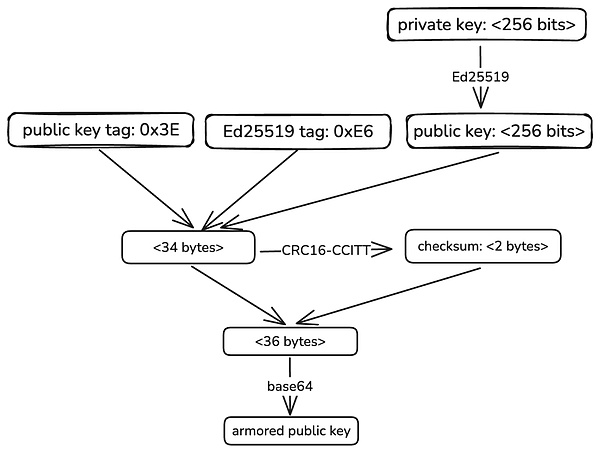
There are two forms of public keys. One is the original public key calculated from the private key, such as:
E39ECDA0A7B0C60A7107EC43967829DBE8BC356A49B9DFC6186B3EAC74B5477D
It is naive to think that the public key can get the account address like Ethereum. The user's public key alone is not enough to calculate the user's account address. We just said that the user's account address is a smart contract address, but we don't even have an account, how to deploy a smart contract? The correct order is to calculate the address first, receive a little initial amount of tokens, and then deploy the contract. The calculation process of the account address is shown in the figure below:
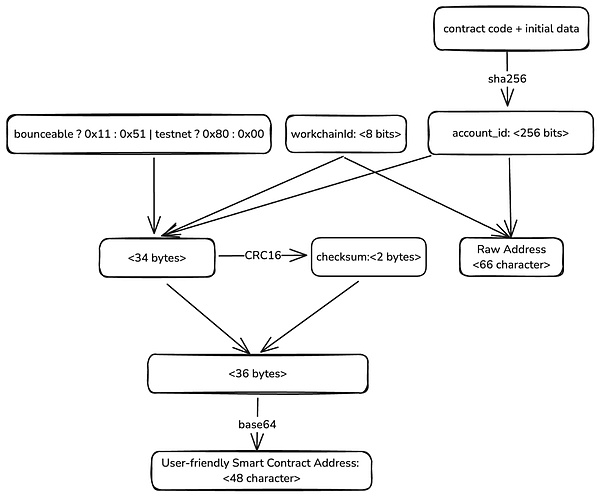
The user's address also has multiple forms. The first is the original form, such as:
0:b4c1b2ede12aa76f4a44353944258bcc8f99e9c7c474711a152c78b43218e296
and the user-friendly form, such as:
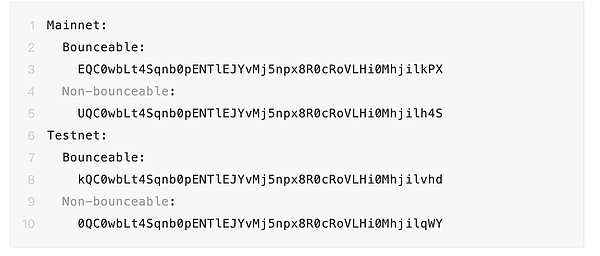
A careful look at these addresses shows that they differ only in the first and last characters. The `account_id` in the middle is the same, but we still cannot see the relationship between the public key and the account address. In fact, the mystery lies in the `initial data` at the beginning, which contains a user's public key, through which the user controls the ownership of the wallet contract. `workchainId` is easy to understand. TON is not just a single chain. It is composed of a lot of shards. Each shard is part of the entire network and handles a specific set of accounts and transactions. In order to locate and manage smart contracts, it is necessary to clearly indicate which shard they are located in. What is the difference between `Bounceable` and `Non-bounceable`? This is related to the working mechanism of smart contracts. Let's continue to look down.
Wallet Contract
The following is a source code of a user wallet contract. You can see that it reads 4 parameters when receiving the user's message.
Yes, when deploying this user's wallet contract, some initial parameters need to be passed in, including a 256-bit public_key information, which ensures that each user has an independent contract address when using the same contract code. All transactions initiated by the user need to sign `in_msg`, and then verify the signature (check_signature) through their own wallet contract, and then the contract will call all operations on the chain. From this we can also infer that a user's public key can actually correspond to countless wallet addresses. You only need to deploy wallets with different source codes or different initialization data to get completely different contract addresses.
Jetton Token
Token is the representation of assets on the chain, so it is a basic element we need to understand. Jetton is the standard form of TON token. Jetton consists of two contracts, Jetton-minter and Jetton-wallet:
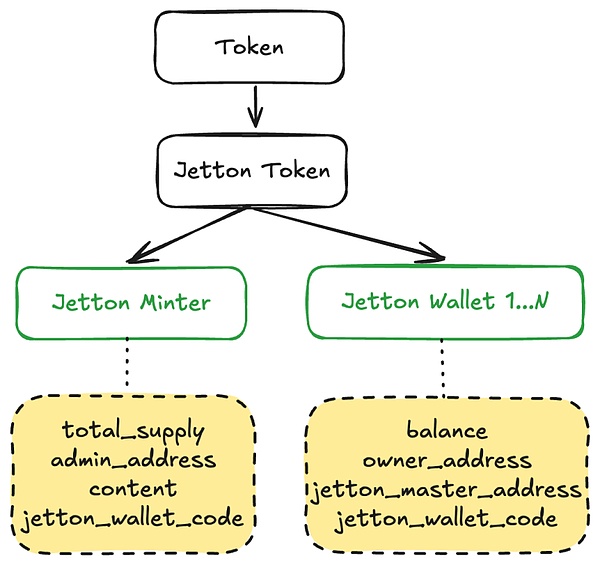
When the token is issued, a Jetton-minter contract will be created. The contract initialization records the total amount of tokens, administrators, wallet codes and other information.
When the token is distributed to the user, the Minter contract will deploy a wallet contract for the user, and record the user's balance, ownership, token Minter contract address, user wallet code and other information when the contract is initialized. Each user will deploy a contract independently. Note that the contract created here is a wallet contract for managing specific Jetton tokens, which is different from the user's account wallet contract. The owner_address here records the user's account wallet address.
When user Alice transfers money to user Bob, the call relationship is as follows:
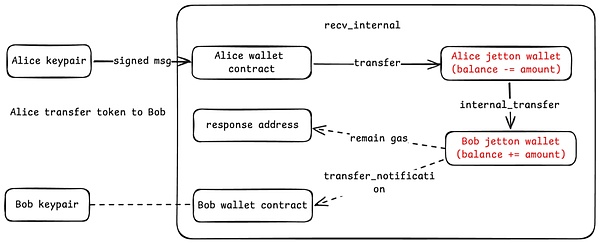
Alice signs the APP under the chain and issues operation instructions by calling her wallet contract. These instructions will further call her token wallet to transfer money. When Bob's token wallet receives the token, it will notify Bob's wallet contract (that is, the Owner address of Bob Jetton-wallet). If there is remaining Gas during the transaction, it will also be returned to the response address, usually Alice's account contract.
This is a Jetton token transfer parsed by the Tonviewer browser:

An ERC20 transfer requires at least one contract call, while a Jetton token transfer requires at least four contracts. This is done to allow transfers to be performed concurrently on the chain to improve transaction efficiency.
Transactions
When certain events occur to an account in TON, it triggers a transaction. The most common event is "receiving a message". The transaction includes the following:
The incoming message that initially triggered the contract (there is a special triggering method)
The contract action caused by the incoming message, such as updating the contract's storage (optional)
Outgoing messages sent to other participants (optional)
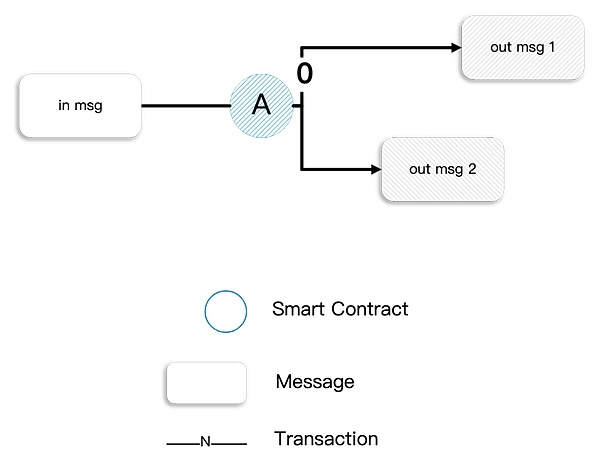
There are several features to note about transactions:
1. Asynchronous: TON transactions are not completed in one call. It may need to pass messages to multiple different smart contracts to execute a series of calls. Due to different routes in the shard chain, TON cannot guarantee the order of message passing between multiple smart contracts.
2. Handling Fees: The asynchronous feature also brings a problem, that is, the consumed handling fees are difficult to estimate. Therefore, when initiating a transaction, the wallet usually sends more tokens as handling fees. If the called contract has a good handling fee processing mechanism, the remaining handling fees will eventually be returned to the user's wallet. Users may observe that the wallet tokens suddenly become less, and then become more after a few minutes. This is the reason.
3. Bounce: Bounce is an error handling mechanism of the contract. When the called contract does not exist or throws an error, if the transaction is set to be reboundable, it will bounce back a bounced message to the contract that initiated the call. For example: if a user initiates a transfer and the call process goes wrong, a bounce message is needed so that the user's wallet contract can restore its balance. Almost all internal messages sent between smart contracts should be resilient, that is, their "bounce" bit should be set.
Asset Security
TON has many features that can bring security issues, so users also need to be aware of some common traps.
Fees withholding attack
As mentioned above, wallets often need to send more fees to prevent transaction execution failures, which gives attackers an opportunity to do evil. If you are a TON wallet user, you may have encountered such a situation. You always receive various NFTs or tokens in your wallet. You thought they were just some junk token airdrops, but when you check the transaction information, you can actually sell them for a lot of money? But when you initiate a transaction, you find that the required fee is super high (1 TON). At this time, you need to pay attention. This may be a fee scam.
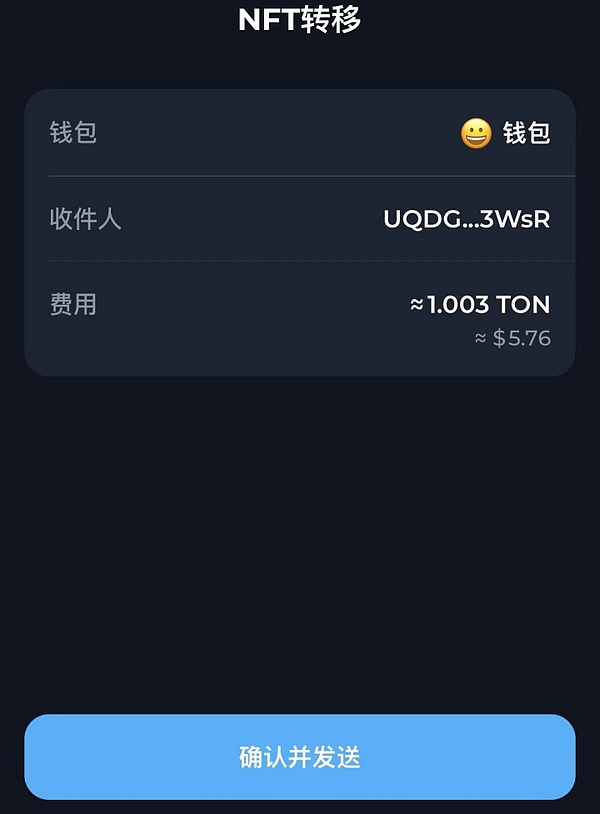
The attacker used a carefully constructed token contract to make the wallet's estimated transfer fee extremely high, but in actual execution, only the fee was intercepted and no transfer message was sent.
First and last number phishing
First and last number phishing is not unique to TON, but exists in all major public chains. The attacker will generate a high-imitation account with the same first and last number for each user address in the entire network. When the user sends a transfer, the attacker also sends a small transfer with the high-imitation account, with the purpose of leaving a record in the user's payment record. When the recipient wants to transfer a token back, he may copy the address from the historical record, and it is likely to be copied to the attacker's address, resulting in a transfer to the wrong address. The attacker can accurately grasp the user's behavior.
Comment Phishing
TON can add a comment when transferring money to note the transaction information. This function is frequently used when recharging on exchanges. Exchanges usually require users to note their user IDs when recharging. However, this function is often used maliciously, and attackers defraud users' assets by writing fraudulent information in the remarks. As shown in the figure:
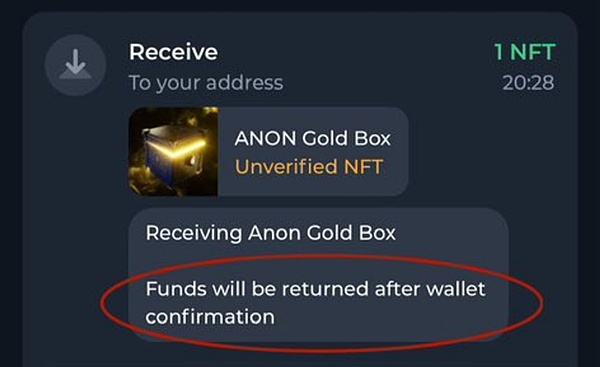
Users should pay special attention to the Anonymous Telegram Number NFT. If the user opens a TG number with the Anonymous Telegram Number but does not open Two-Step Verification, once the NFT is phished away, hackers can directly log in to the target TG number to carry out subsequent asset theft and fraud.
Smart Contract Vulnerabilities
Security vulnerabilities in smart contracts can cause users to lose funds placed in smart contracts. Users need to choose projects that have been well audited. TON's smart contracts are mainly programmed in FunC language, and some use more advanced Tact or lower-level Fift, which are highly original languages. New programming languages will bring new security risks, especially for developers. They should have good habits of secure programming, master best security practices, and undergo strict security audits before deploying production environments. Due to space limitations, this article does not discuss contract security. The SlowMist Security Team has launched the TON smart contract security audit service, and welcomes friends with audit needs to discuss it together.
Fake recharge attack
Wallet or exchange users need to be aware of fake recharge attacks, which are usually of two types:
Fake currency, the attacker issues a token with the same metadata as the target token. If the automated account entry program does not check whether this is the correct minter contract, it will result in an incorrect entry.
Bounce, TON's transfer process requires a call relationship between the wallet contracts of two users. If the recipient's wallet contract does not exist and the transaction is set to Bounceable, the message will be bounced and the original funds will be returned to the sender after deducting the handling fee. Friends who are interested in the details can check our previously disclosed fake recharge article.
Summary
This article introduces some basic technical principles of TON from the perspectives of TON's public and private key creation, wallet contracts, token forms, transaction characteristics, etc., and also discusses possible security issues in the process of using TON. I hope it can bring inspiration to everyone's study.
 JinseFinance
JinseFinance













